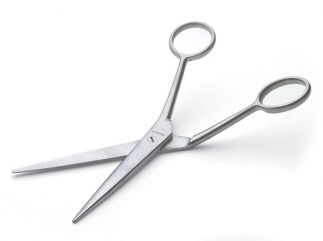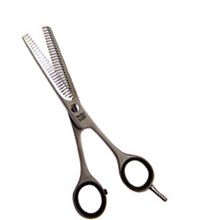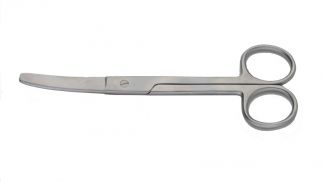Scissors
Grooming scissors
(This is directed at the pet owner intending to groom their own pet/s and not the professional groomer.)
As any professional groomer will tell you there is a lot more to cutting a dog’s hair with scissors, even more so than in trimming and it requires a lot of skill and practice which is not achieved quickly.
Scissoring a coat is a skill, and one best learnt from a reliable source such as a bespoke groomer’s train school or on a specific scissoring course with professional tutors suitably qualified.
Even as a student, do not be under the impression that you will be able to create a magnificent sculpture within the first weeks. You will need plenty of “hands on” practice under the guidance of a professional before you reach such standards.
Before using scissors on your dog or anyone else’s it’s important to recognise that there are certain types of hair that can be cut while there are others that can’t. Curly hairs that can be pulled with a brushing are perfect for cutting with scissors. Longer hair, whether straight, or of full body volume is best not cut using scissors as you will very likely end up with a dreadful uneven result. This type of hair is often best cut using a clipper, or if you intend using scissors just do enough to even it out.
Be certain before you make a start either with scissors or a clipper that the animal’s coat is dry, completely and correctly brushed out, with no trace of knots or evidence of mats.
A more advanced type of scissoring is used in sculpting which defines imaginary lines that will be done in as uniform away as possible, these will then be the definite lines to follow the cut. This is a technique, which needs professional tuition to prefect.
There are some basic scissor rules to learn and there after to adopt.
Initially, start with a pair of scissors you feel comfortable with. The choice is huge. Get a good pair – resist cheap makes – the price may be attractive but the quality usually is not!
The German made “Roseline” brand are one of the best for both professional and novice use. The range is professional with suitable scissors for every task. Roseline are an internationally known product brand recognised for typical German engineering and the usual exceptional quality. All “Roseline” scissors are made from German Solingen steel – the result – a quality lasting cutting edge!
Trimming scissors are like needlework cutting scissors – one specific use only! Refrain from other uses such as cutting paper or worse! Be particular where and how they are sharpened.
Learn how to hold and apply the scissors correctly with finger and thumb correctly inserted in the handle “holes” At first this may feel strange, but you soon get accustomed to the feel.
Don’t be nervous, keep a steady and free flowing hand. Start out by cutting less than you actually intend to take off, go back and take off more until you feel you have the shape as you wish and then go back and even it all out. Remember it is much easier to keep cutting – you cannot put it back if you get too carried away!
Try to cut in a consistent and uniform way following a pre-conceived concept of what you require. Don’t rush off to different parts of the body and do a bit here there and everywhere! Work out what you want to achieve in your mind’s eye and then adopt a “pattern” plan and follow it.
If your dog is willing to cooperate and will oblige by stand with its legs extended this will make your life a lot easier as you can then get a clearer visual picture of the lines you are trying to achieve.
When attempting a task such as scissoring you want to be comfortable whilst working. A grooming table upon which to stand your dog whilst you work will make the job a lot easier on you and your back!
Scissoring is worth learning, the ability to be able to grooming your own pet and to receive applause for the results is very satisfying, but nothing quiet equals the knowledge that when you look down – the result you see is your skills on your pet!
WORD of ADVICE!
Even good quality scissors – need from time to time to be sharpened.
Scissor sharpening needs to be undertaken by those who not only have the right equipment for the purpose, but who also know and understand the requirements of the many types of scissors and especially good quality thinning scissors.
Thinning scissors should not be sharpened on BOTH blades, only on the flat surfaced cutting blade.
DO NOT ATTEMPT to sharpen the “toothed” blade – individual teeth have in most cases a very small “v” shape notched into the tooth – if ground in the sharpening process the scissor will invariably be ruined!
Showing all 3 results
-

Cranked Scissors
£17.50 + VAT (£21.00 Inc VAT) Add to cart -

Thinning Scissors
£9.75 + VAT (£11.70 Inc VAT) Add to cart -

Wahl Curved Scissors
£6.95 + VAT (£8.34 Inc VAT) Add to cart
Showing all 3 results
